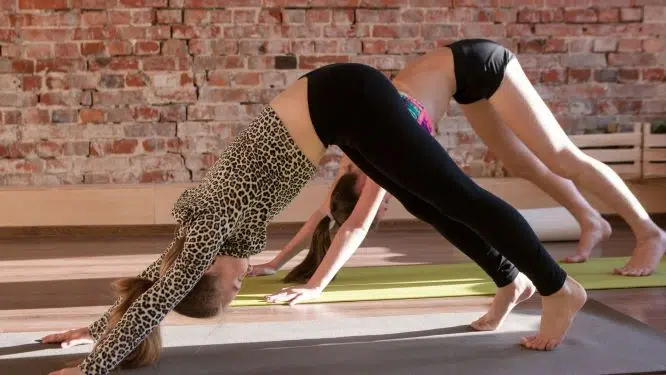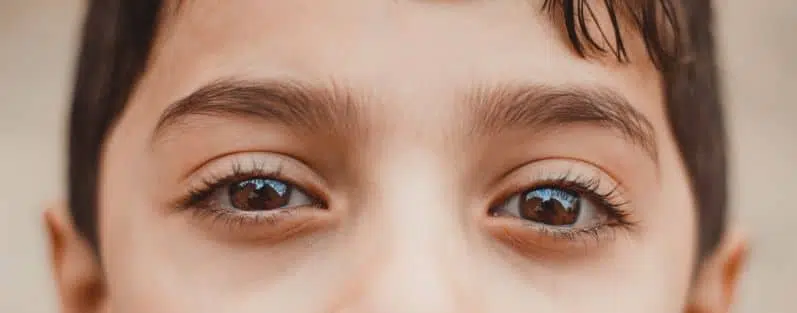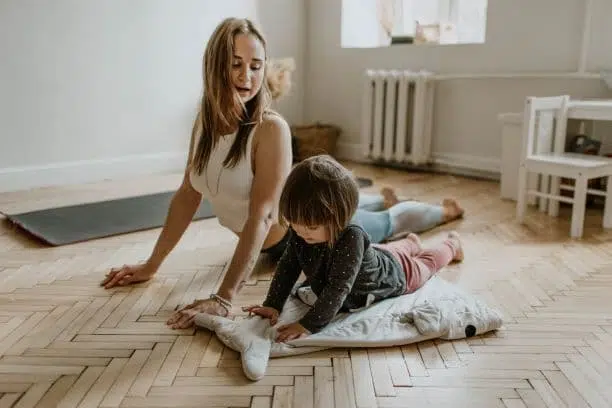Children love to move about! You’ve probably noticed this – but how do you link this to being mindful?
Mindfulness activities have huge benefits for children. It relaxes them, calms them down, and helps them think and learn much better. But how do you get them to be mindful and move at the same time?
By playing mindful movement games, that’s how!
In my decade-long career teaching young children, definitely my favorite mindful movement games are the following:
- Noisy Running
- Heartbeat Statues
- Eagle Flying
- Animal Dancing
- Eye-Openers
- Superhero Heartbeats
- Floating Balloons
- Shake and Smile
- If You’re Happy And You Know It
- Melting Moments
- Yoga Trees
- Yoga Animal Moments
- Qigong Beachball
- Rain Falling
These movement games have many benefits such as:
- Root children in the present
- They help children think about how their bodies work
- They allow for periods of activity, then periods of calm
- They promote mental health
- Develop simple listening and attention skills
- Excellent cardio exercise
- They are fun!
There is quite a bit of research that demonstrates the impact mindfulness games can have on children in reducing anxiety and creating more positive behavior (Source).
I’m going to give you a description of all 14 of these activities, so you will be able to have a full toolkit to mix up movement and mindfulness for ever more.
So, let’s get cracking…

1. Noisy Running
This is quite a crazy game, but they really do love this one.
It’s really good for a sense of liberation and ‘letting go.’
It is best done in a big space. The children are going to move around in the space, and they are going to make a noise that suits the way they are moving.
Start with everyone walking around slowly, and making a really quite noise whilst doing it. Something like a low ‘aahhh’ is normally the way to go.
Then walk a bit faster, and the noise gets a bit louder at the same time.
Then encourage the children to jog, and the noise will be much louder.
Lastly, get the children to run around the space, and they will be yelling as loud as possible – ‘AAAAHHHH!’ This feels great! It combines freedom, and just having fun.
Mix up the ways they move after this. Alternate between fast and slow movements, with associated noises.
The children can also freestyle – i.e. just choose their movements themselves, and make up the type of noise that goes well with it.
After the really loud yelling, you can all stop on the spot for a few moments of mindful pause. You could ask mindful questions, such as, ‘What did that feel that?’ ‘What does you heart feel like?’
2. Heartbeat Statues
This game is a bit like the all-time classic ‘musical statues’, combined with mindfulness – a truly great combination.
For this game you need at least two very different types of music, and a way of flitting between the two reasonably quickly.
Ideally you need one fast-paced upbeat piece of music, and another one that is much more peaceful and relaxed.
Start with the peaceful one first. Encourage the children to dance in a languid and relaxed way.
At any given moment, stop the music, and the children will freeze on the spot.
Ask them to feel their heart beats, by putting their hand on their chest. What does it feel like?
Then play the high-paced piece of music, and encourage to jive an dance about in a high-tempo way.
Same again, when the music stops then everyone will freeze. What do their heart beats feel like now?
Keep flitting between the two pieces of music, and you could potentially have a whole range of different styles of music to extend this game.
3. Eagle Flying
This is a beautiful and simple game that combines deep breathing with movement.
Deep breathing is fantastic for children, as it is the thing that can calm them down the most quickly. For the ultimate breathing games for children, check this article that I wrote out.
The children are going to pretend to be eagles.
They put their arms out wide at their sides, and they are going to soar about a wide space, gracefully beating their arms really slowly.
As their arms go up they are going to breathe in through their nose.
As they go down, they will breathe out through the mouth.
Keep going like this, breathing and beating their ‘wings’ at the same time.
4. Animal Dancing
This is another game that is all about letting go, and releasing pent up feelings.
Choose one child to be the ‘leader’, or potentially an adult could take this role. The leader is going to dance about like an animal.
For example, they might be a monkey – beating their chest, going ‘oo oo oo’ and running about on all fours. The others copy! It’s all about really going for it.
Then they leader will try a different animal, and the others copy.
The adult could ask questions to try to extend the types of movement.
Have a go with a few different leaders.
It’s nice at some points for everyone to sit down and close their eyes. These moments of calm are a super thing to add to any movement game.
If you’re looking for more animal games in particular, check out this article of animal parachute games.
5. Eye Openers
This ‘eye openers’ game really brings the wonder of how your eyes work to forefront of children’s attention.
We use our eyes every waking moment. In mindfulness, we particularly use them to take mental snapshots, study objects and notice changes.

This adult-led game helps children to practice using their eyes.
It is a sequence of eye exercises and movements, that you model and the children try to copy.
Some great exercises include:
i) Look up, look down, look left, look right
ii) Make your eyebrows dance – both of them together
iii) Can you do one eyebrow at a time?
iv) Can you blink slowly?
v) Blink very fast
vi) Roll your eyes
vii) Open your eyes wide
viii) Close your eyes
ix) And repeat
Then try to close your eyes. What do you ‘see’ when your eyes are closed?
6. Superhero Heartbeats
This is a game that combines mindfulness with superheroes and missions.
The children are all superheroes that have different abilities. Tell them what the abilities are and how to pretend to do them.
For example, some good ideas are:
Fly – they soar around with arms out
Bounce over bulidings – jump around
Shrink – crawl around
Freeze – stand still on the spot
The children move about in different ways, following the instructions, and then ‘freeze’. This is the perfect opportunity to encourage them to feel their heart beat. How does it feel?
You could adapt this game for different animal movements, or just different moves in general.
7. Floating Balloons
This is a beautiful calming game. It is best played over a wide area.
Children really love balloons, and all the games you can play with them. This game takes this into an imaginary level.
Get the children to stand on the spot and close their eyes. They are going to pretend that they are turning into balloons.
Ask them to imagine how light they feel. What colour would they like to be?
Then take a deep breath in, so that the balloon is fully inflated.
Then the children are going to open their eyes, and start ‘floating’ around the space. Model how you think a balloon might move if any of them are unsure.
They can very gently bounce off walls. And the whole experience is all about floating and bouncing in a calm and ethereal way
8. Shake And Smile
You may have seen videos of hippies in the sixties trying out things like this at music festivals, and this activity is a great way of releasing tension and feeling great!
Stand on the spot to start with. Start gently wiggling and shaking your legs.
Then shake your legs and hips, and then shake your stomach, shoulders and head as well. As you keep going you can shake everything more forcefully. You can also start moving around, giving everything a good old shake.
It really helps if you smile as well. Smile, close your eyes, and shake!
Then ask them to stop, close their eyes, and ask how they feel.
9. If You’re Happy And You Know It!
This is a way of adapting the classic song to incorporate different emotions and ways of moving that relate to those feelings.
Always finish with the happy verse at the end to lift the mood!
Here are some examples of verse lyrics with actions:
‘If you’re happy and you know it…’
Clap your hands
Smile
Thumbs up
Shout ‘Hooray!’
‘If you’re angry and you know it…’
Frown
Stamp your feet
Shout ‘No!’
‘If you’re sad and you know it…’
Cry and cry
Mooch about
‘If you’re tired and you know it…’
Yawn real wide
If you’re excited and you know it
Go ‘Yippee!’
Cheer and shout!
This is a good song for acting out what emotions look like in real life (check out 14 emotion games for young children here).
10. Melting Moments
The idea of this game is that you are going to visualise being something that melts.
So you could be a snowman on a warm day, or a bar of chocolate in the sun.
The children stand in a space, and close their eyes. They imagine (as an example) that they are a snowman. They start to feel the warm sun beating down on them.
They can feel their bodies start to melt and sink downwards towards the ground.
Start moving and crouching down towards the floor. In the end the children will have fully ‘melted’ and be lying on the floor.
Take a few moments to breathe deeply, and just savour the experience.
11. Yoga Trees
Yoga is fantastic for children. It really helps them to relax and be in the present (find out the best 28 relaxation games for young children here.)
A good way to start them off is to get them to visualise the poses in terms of real things that they understand. In this case, the real thing is a tree.
The children are going to stand on the spot, pretending to be trees.
Ask them to close their eyes. Then encourage them to imagine that their roots are growing out of their feet deeply into the ground.
Then ask them to imagine that this growth is continuing up through their bodies. They put their arms out as this magical growing continues up through their ‘branches’. They can imagine leaves sprouting out of their fingers.
Then imagine the wind is blowing harder through their branches. The wind rocks the tree! It blows harder and harder!
At last it dies down to a gentle breeze, and finally vanishes.
How do the children feel?
12. Animal Yoga Poses
Another excellent way to teach simple yoga, is by trying out poses that mimic animals. Some of the easiest ones are these:
Giraffe Pose
For this one, the children stand up straight with one front in of the other. Reach up with both hands as high as possible, and then circle your arms and hands down until you are touching you toes. Hold this position for a few moments before repeating.
Seal Pose
Lie flat on your belly.
Have your hands flat on the floor in front of either shoulder. Push upwards with your hands until your arms are straight.
You lower body will still be touching the floor, but your upper body will be raised, with your back curved (looking like a seal).

Downward Facing Dog
This is one of the most famous yoga poses.
The idea is to try to make an upside-down ‘v’ shape with your body.
Start with your hands and feet touching the floor so that you are on all-fours. Push your body upwards so that you end up with both legs and back straight. You will be in a triangle shape (hopefully). Hold this pose for a while, breathing deeply.
13. Qigong Beach Ball
QiGong is similar to Tai Chi. It is a beautiful system of simple movements.
Some of these are very achievable for children, especially the ones that they can visualize with objects that they understand.
For the beach ball movement game, the children all stand in a space, with their feet at shoulder width.
They imagine they are holding a large beachball. Have their hands low underneath the beach ball to start with, roughly around their midriff.
Keeping their hands together, they are going to rotate around the big beach ball until their hands are front of their face.
Then they are going to push straight down towards their midriff again.
The upwards movement is to inflate the beach ball, the pushing down deflates it.
Encourage them to breathe in as they go up, and out as they go down. Repeat this movement for a couple of minutes.
14. Rain Falling
This is another beautiful visualisation activity, that is also involving simple self-massage.
The children stand in a space and are going to imagine that it is raining. Their fingers are going to start making a pitter-patter movement, wiggling up and down gently.
Imagine the rain is falling on your head, and try the pitter-pattering over hair, then down your face.
Visualise the rain landing all over your body now. Gently bring your wiggling fingers over your arms, chest, and down your legs and your feet.
Then, imagine the rain has suddenly stopped. Brush the ‘water’ off yourself.
Then visualise that you are drying out in the hot sun, with any wetness steaming off you.
Final Thoughts
Mindfulness can be made really child-friendly by combining it with movement, and getting children active.
If you’ve found this article useful, then another one you will really enjoy is 18 Mindfulness Art Activities For Children.
Good luck with the mindfulness and movement!
